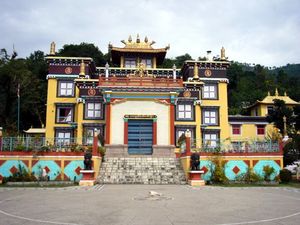Tashi Jong: Difference between revisions
m (→External Links) |
(→External Links: facebook) |
||
| (One intermediate revision by the same user not shown) | |||
| Line 3: | Line 3: | ||
==History== | ==History== | ||
After escaping from Tibet in 1958, the [[8th Khamtrul Rinpoche]] had a vision to establish a traditional Tibetan community for the preservation and perpetuation of Tibet’s endangered culture, sacred arts, and Buddhist heritage in exile. Nestled in the foothills of the Himalayas, not far from [[Dharamsala]], Khamtrul Rinpoche established the community of Tashi Jong (Auspicious Valley) for the monks, [[lama]]s, [[tokden]]s and lay people who followed him into exile from [[Kham]], Eastern Tibet. All together they worked to clear the land and to rebuild on foreign soil the renowned [[Drukpa Kagyü]] monastery of [[Khampagar Monastery]]. Here the precious teachings of the [[Buddha]] could be safe for future generations. In 1980, the 8th Khamtrul Rinpoche passed away and in the same year, the [[9th Khamtrul Rinpoche]] was born. | After escaping from Tibet in 1958, the [[8th Khamtrul Rinpoche]] had a vision to establish a traditional Tibetan community for the preservation and perpetuation of Tibet’s endangered culture, sacred arts, and Buddhist heritage in exile. Nestled in the foothills of the Himalayas, not far from [[Dharamsala]], Khamtrul Rinpoche established the community of Tashi Jong (Auspicious Valley) for the monks, [[lama]]s, [[tokden]]s and lay people who followed him into exile from [[Kham]], Eastern Tibet. All together they worked to clear the land and to rebuild on foreign soil the renowned [[Drukpa Kagyü]] monastery of [[Khampagar Monastery]]. Here the precious teachings of the [[Buddha]] could be safe for future generations. In 1980, the 8th Khamtrul Rinpoche passed away and in the same year, the [[Dokhampa Shedrub Nyima|9th Khamtrul Rinpoche]] was born. | ||
There are approximately three hundred lay people and one hundred monks living together in the Tashi Jong community a “little island of Tibetan culture" surrounded by its Indian neighbors. Today there are the modern conveniences of a small and clean guest house, a cafe, and even an internet connection, when power allows. Still after 50 years in exile the vitality of the community's faith, devotion, and determination which permeates all activities sacred and ordinary remains faithful to the 8th Khamtrul's vision. | There are approximately three hundred lay people and one hundred monks living together in the Tashi Jong community a “little island of Tibetan culture" surrounded by its Indian neighbors. Today there are the modern conveniences of a small and clean guest house, a cafe, and even an internet connection, when power allows. Still after 50 years in exile the vitality of the community's faith, devotion, and determination which permeates all activities sacred and ordinary remains faithful to the 8th Khamtrul's vision. | ||
| Line 17: | Line 17: | ||
==External Links== | ==External Links== | ||
*[http://www.tibet.org/tashijong Tashi Jong: A Traditional Tibetan Community in Exile (Tibetan Video Project 1998)] | *[http://www.tibet.org/tashijong Tashi Jong: A Traditional Tibetan Community in Exile (Tibetan Video Project 1998)] | ||
*[https://www.facebook.com/khampa.ghar Official facebook page] | |||
[[Category:India]] | [[Category:India]] | ||
[[Category:Monasteries]] | [[Category:Monasteries]] | ||
Latest revision as of 11:59, 29 November 2017

Tashi Jong — the reestablished seat of Khampagar Monastery in northern India.
History
After escaping from Tibet in 1958, the 8th Khamtrul Rinpoche had a vision to establish a traditional Tibetan community for the preservation and perpetuation of Tibet’s endangered culture, sacred arts, and Buddhist heritage in exile. Nestled in the foothills of the Himalayas, not far from Dharamsala, Khamtrul Rinpoche established the community of Tashi Jong (Auspicious Valley) for the monks, lamas, tokdens and lay people who followed him into exile from Kham, Eastern Tibet. All together they worked to clear the land and to rebuild on foreign soil the renowned Drukpa Kagyü monastery of Khampagar Monastery. Here the precious teachings of the Buddha could be safe for future generations. In 1980, the 8th Khamtrul Rinpoche passed away and in the same year, the 9th Khamtrul Rinpoche was born.
There are approximately three hundred lay people and one hundred monks living together in the Tashi Jong community a “little island of Tibetan culture" surrounded by its Indian neighbors. Today there are the modern conveniences of a small and clean guest house, a cafe, and even an internet connection, when power allows. Still after 50 years in exile the vitality of the community's faith, devotion, and determination which permeates all activities sacred and ordinary remains faithful to the 8th Khamtrul's vision.
Every spring there is the stunning visual feast of sacred lama dances (Tib. cham) celebrating the birthday of Guru Padmasambhava. To witness the overwhelming beauty and experience the spiritual power evoked by these sacred rituals is considered a great blessing. This dance ritual, was first performed in Tibet more than 300 hundred years ago. In 1958, the 8th Khamtrul Rinpoche a master of sacred dancing, carried the knowledge of these dances into exile and Tashi Jong monks and lamas have performed them ever since. Dressed in elaborate costumes of silks and brocades, they dance in highly stylized movements. Solemn chanting and rich tones of traditional temple instruments accompany the dancers, creating a meditation in sound and movement. When the days of ritual are concluded, the merit of the dances is dedicated for the well being of all beings everywhere.[1]
References
- ↑ Tashi Jong: A Traditional Tibetan Community in Exile